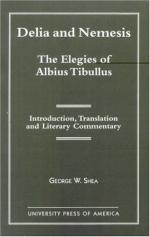|
This section contains 10,462 words (approx. 35 pages at 300 words per page) |

|
SOURCE: "Informing," in his Tibullus: A Hellenistic Poet at Rome, Cambridge: Cambridge University Press, 1979, pp. 144-65.
In the following essay, Cairns explains how Tibullus conveys information in his poems.
… [The conveyance of information] is a vital part of exposition, since without knowing the situation the audience cannot understand the poem. This chapter will examine how Tibullus gives such information.… In a narrative poem the reader must follow the story-line to understand the poem, including any elaborations, descriptions, similes and digressions. But the whole story is not told at the beginning: new facts and incidents are introduced regularly at opportune points—an easy process, since narrative involves time-lapse. The recurrent introduction in a narrative of essential new information has the slight disadvantage that a reader whose concentration lapses at a single point can lose his place. On the other hand, he is not burdened by a large initial conveyance...
|
This section contains 10,462 words (approx. 35 pages at 300 words per page) |

|


